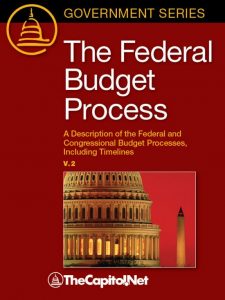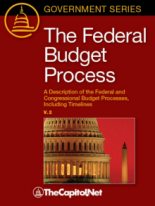The Federal Budget Process, V.2
A Description of the Federal and Congressional Budget Processes, Including Timelines

Web preview on Google Books
Budgeting for the federal government is an enormously complex process. It entails dozens of subprocesses, countless rules and procedures, the efforts of tens of thousands of staff persons in the executive and legislative branches, and the active participation of the President, congressional leaders, Members of Congress, and members of the executive branch. This analysis shows the various elements of the federal budget process including the President’s budget submission, framework, timetable, the budget resolution, reconciliation, the “Byrd Rule,” appropriations, authorizations, and budget execution.
Congress is distinguished from nearly every other legislature in the world by the control it exercises over fashioning the government’s budgetary policies. This power, referred to as “the power of the purse,” ensures Congress’ primary role in setting revenue and borrowing policies for the federal government and in determining how these resources are spent.
The congressional power of the purse derives from several key provisions in the Constitution.
– Article I, Section 8, Clause 1 (Power to tax and spend) declares in part that Congress shall have the power to raise (that is, “to lay and collect”) revenues of various types, including taxes and duties, among other things.
– Article I, Section 8, Clause 2 (Borrowing power) declares that the power to borrow funds “on the credit of the United States” belongs to Congress. In addition to its powers regarding revenues and borrowing, Congress exerts control over the expenditure of funds.
– Article I, Section 9, Clause 7 declares in part that funds can be withdrawn from the Treasury only pursuant to laws that make appropriations.
Under the Constitution, revenue measures must originate in the House of Representatives. Beyond this requirement, however, the Constitution does not prescribe how the House and Senate should organize themselves, or the procedures they should use, to conduct budgeting. Over the years, however, both chambers have developed an extensive set of rules (some set forth in statute) and precedents that lay out complicated, multiple processes for making budgetary decisions. The House and Senate have also created an intricate committee system to support these processes.
As American society has grown and become ever more complex, and as the role of the federal government in the national economy has steadily expanded, Congress also has increasingly shared power over budgetary matters with the president and the executive branch. It has refashioned the president’s role in budgeting by requiring him to submit to Congress each year a budget for the entire federal government and giving him responsibilities for monitoring agencies’ implementation of spending and revenue laws. Accordingly, the president also exercises considerable influence over key budget decisions.
2018, 388 pages
Softcover $19.95
V.2
ISBN: 1587332930
ISBN 13: 978-1-58733-293-7
Buy softcover from TheCapitol.Net
Buy softcover from Bookshop
Buy softcover from Amazon
Buy softcover from Barnes & Noble
Ebook: $9.95
EISBN: 9781587332944
Buy ebook from Google
Table of Contents
1. “Introduction to the Federal Budget Process,” CRS Report 98-721, December 3, 2012 (38-page PDF![]() ) (CRS R46240, February 26, 2020, 48-page PDF
) (CRS R46240, February 26, 2020, 48-page PDF![]() )
)
2. “The Executive Budget Process: An Overview,” CRS Report R42633, July 27, 2012
3. “The Executive Budget Process Timetable,” CRS Report RS20152, December 5, 2012 (8-page PDF![]() )
)
4. “The Congressional Budget Process: A Brief Overview,” CRS Report RS20095, August 22, 2011 (CRS R46468, January 10, 2023, 15-page PDF![]() )
)
5. “Budget Resolution Enforcement,” CRS Report 98-815, August 12, 2008
6. “Deeming Resolutions: Budget Enforcement in the Absence of a Budget Resolution,” CRS Report R44296, June 26, 2017 (CRS 44296, June 8, 2022, 26-page PDF![]() )
)
7. “Legislating in Congress: Federal Budget Process,” Contributing Author Bill Heniff Jr., with updates by Robert Keith and Megan Lynch
8. “The Budget Reconciliation Process: Stages of Consideration,” CRS Report R44058, January 4, 2017 (CRS 44058, January 25, 2021, 16-page PDF![]() )
)
9. “The Budget Reconciliation Process: The Senate’s ‘Byrd Rule’,” CRS Report RL30862, November 22, 2016 (44-page PDF![]() ) (See “The Budget Reconciliation Process: The Senate’s ‘Byrd Rule’,” CRS Report RL30862, September 28, 2022 (45-page PDF
) (See “The Budget Reconciliation Process: The Senate’s ‘Byrd Rule’,” CRS Report RL30862, September 28, 2022 (45-page PDF![]() ))
))
10. “The Congressional Appropriations Process: An Introduction,” CRS Report R42388, November 30, 2016 (28-page PDF![]() )
)
11. “Allocations and Subdivisions in the Congressional Budget Process,” CRS Report RS20144, November 29, 2010
12. “Omnibus Appropriations Acts: Overview of Recent Practices,” CRS Report RL32473, January 14, 2016
13. “Appropriations Report Language: Overview of Development, Components, and Issues for Congress,” CRS Report R44124 July 28, 2015 (CRS R44124, March 22, 2023, 37-page PDF![]() )
)
14. “Overview of the Authorization-Appropriations Process,” CRS Report RS20371, November 26, 2012 (5-page PDF![]() ) (See “Authorizations and the Appropriations Process,” CRS Report R46497, May 16, 2023, 17-page PDF
) (See “Authorizations and the Appropriations Process,” CRS Report R46497, May 16, 2023, 17-page PDF![]() )
)
15. “Points of Order in the Congressional Budget Process,” CRS Report 97-865, October 20, 2015 (21-page PDF![]() )
)
16. “The Budget Control Act: Frequently Asked Questions,” CRS Report R44874, February 23, 2018 (CRS R44874, October 1, 2019, 19-page PDF![]() )
)
17. “Budget ‘Sequestration’ and Selected Program Exemptions and Special Rules,” CRS Report R42050, June 13, 2013 (35-page PDF![]() )
)
18. “Continuing Resolutions: Overview of Components and Recent Practices,” CRS Report R42647, January 14, 2016 (CRS R42647, April 19, 2019, 38-page PDF![]() )
)
19. Additional Resources
- Federal Budget Links and Research Tools
- Understanding Congressional Budgeting and Appropriations, TCNUCBA.com
- Advanced Federal Budget Process, TCNAFBP.com
- Congressional Dynamics and the Legislative Process, TCNCDLP.com
- Appropriations Process in a Nutshell with James Saturno, ISBN 1-58733-043-1
- Authorizations and Appropriations in a Nutshell with James Saturno, ISBN 1-58733-029-6
- The Federal Budget Process with Philip Joyce, ISBN 1-58733-083-0
Laws, web sites, and books
TCNBudget.com
Custom On-Site Training
Capitol Learning Audio Courses TM
Index
TheCapitol.Net is a non-partisan firm, and the opinions of its faculty, authors, clients and the owners and operators of its vendors are their own and do not represent those of TheCapitol.Net.
TheCapitol.Net/Publications/GovernmentSeries/1519_FederalBudgetProcess.html
FederalBudgetProcess.com
TCNTFBP.com
For more than 40 years, TheCapitol.Net and its predecessor, Congressional Quarterly Executive Conferences, have been teaching professionals from government, military, business, and NGOs about the dynamics and operations of the legislative and executive branches and how to work with them.
Our custom on-site and online training, publications, and audio courses include congressional operations, legislative and budget process, communication and advocacy, media and public relations, testifying before Congress, research skills, legislative drafting, critical thinking and writing, and more.
TheCapitol.Net is on the GSA Schedule, MAS, for custom on-site and online training. GSA Contract GS02F0192X
TheCapitol.Net is now owned by the Sunwater Institute.
Teaching how Washington and Congress work ™


